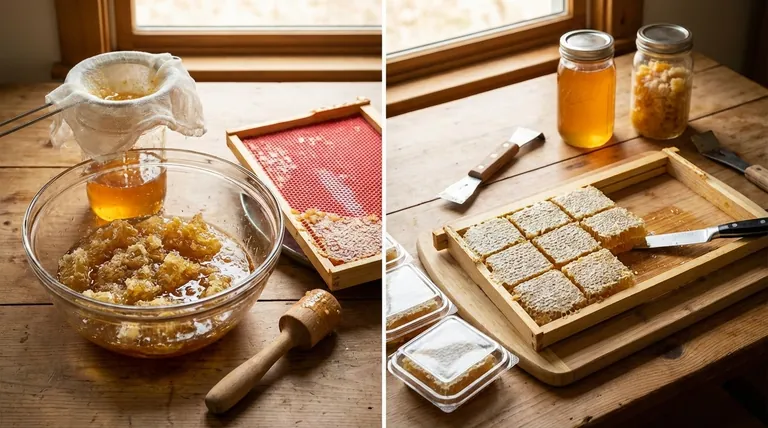For beekeepers looking to bypass mechanical equipment, the two primary methods for extracting honey without a honey extractor are the 'Crush-and-Strain' method and the 'Cut-Comb' method. The correct choice between them depends entirely on the type of foundation—the base of the frame your bees build upon—that you use in your hive.
The core decision you face is whether to sacrifice the beeswax comb. A mechanical extractor preserves the comb for reuse, saving your bees immense energy, while non-extractor methods either destroy the comb to release liquid honey or package it for direct consumption.

Why Manual Extraction is a Practical Choice
For new or small-scale beekeepers, the cost and storage space required for a mechanical extractor can be prohibitive. Understanding the manual alternatives allows you to harvest your honey with minimal investment.
The Purpose of a Honey Extractor
A honey extractor is a centrifuge. It spins frames at high speed, using centrifugal force to sling the honey out of the wax cells while leaving the delicate, drawn-out honeycomb structure intact for the bees to refill.
The Advantage of Preserving Comb
Bees expend a significant amount of energy and resources to produce wax and build out the honeycomb. By preserving this comb, an extractor allows the colony to focus its energy on gathering nectar and making more honey, rather than rebuilding their pantry from scratch.
Method 1: The Crush-and-Strain Technique
This is the most common non-mechanical method for producing liquid, bottled honey. It is effective but results in the complete destruction of the wax comb.
When to Use This Method
The Crush-and-Strain method is necessary when your frames have a rigid base, such as plastic foundation or thick, reinforced wax foundation. The comb must be scraped off this base to be processed.
The Step-by-Step Process
First, you use a hive tool or scraper to remove all the honeycomb from the frame's foundation, letting it fall into a clean, food-grade bucket. Next, you mash or crush the comb thoroughly to break open all the wax cells.
Finally, you pour the mixture of honey and crushed wax through a series of strainers or cheesecloth to separate the liquid honey from the solid wax particles.
Method 2: The Cut-Comb Technique
This method is less about extracting honey and more about packaging it in its most natural form. The honey is not separated from the comb; it is consumed together.
When to Use This Method
Cut-Comb is the ideal method for frames that have no foundation (foundationless frames) or use a special, extra-thin foundation designed to be edible.
The Step-by-Step Process
The process is straightforward: you simply use a sharp knife to cut clean squares or sections of the honeycomb directly from the frame. These sections are then packaged for sale or consumption.
Understanding the Trade-offs
Choosing a manual method involves accepting certain compromises compared to using an extractor. Your decision impacts both your bees' productivity and your own time.
The Cost to Your Bees
The primary trade-off is the loss of drawn comb when using the Crush-and-Strain method. Your bees must work much harder to rebuild that wax structure before they can begin storing honey again in the next season.
Labor, Scale, and Cleanliness
Both manual methods are significantly more labor-intensive per frame than using an extractor, making them suitable only for a small number of hives. The Crush-and-Strain method, in particular, can be a messy process that requires careful filtering to achieve pure honey.
Making the Right Choice for Your Apiary
Your equipment and your final product goals will dictate the best path forward for your honey harvest.
- If your primary focus is producing liquid honey from frames with plastic foundation: The Crush-and-Strain method is your only viable non-mechanical option.
- If your primary focus is a natural product from foundationless frames: The Cut-Comb method provides a beautiful and simple way to harvest without any processing.
- If your primary focus is maximizing honey production and minimizing bee workload: Investing in a mechanical extractor is the most efficient long-term strategy.
Ultimately, understanding these methods empowers you to harvest your honey effectively, no matter the scale of your beekeeping operation.
Summary Table:
| Method | Best For Foundation Type | End Product | Key Trade-off |
|---|---|---|---|
| Crush-and-Strain | Plastic or reinforced wax | Liquid, bottled honey | Destroys comb; bees must rebuild |
| Cut-Comb | Foundationless or thin, edible wax | Honeycomb sections | No liquid honey; comb is consumed |
Ready to scale up your honey harvest? As your dedicated wholesale partner, HONESTBEE supplies commercial apiaries and beekeeping equipment distributors with the durable, high-performance extractors and supplies needed for efficient, large-scale operations. Let us help you maximize your yield and minimize bee workload. Contact our expert team today to discuss your apiary's needs!
Visual Guide

Related Products
- HONESTBEE 3-Frame Manual Acrylic Honey Extractor
- electric honey extractor honey centrifuge 3 frame honey extractor stainless steel honey frame extractor
- Electric 8 Frame Honey Spinner Extractor Equipment for Beekeeping
- Stainless Steel 3 Frame Manual Honey Extractor Spinner for Bee Honey Extraction
- 8-Frame Electric Self-Reversing Honey Extractor Spinner for Commercial Honey Extraction Equipment
People Also Ask
- What machines are needed in beekeeping besides basic tools? Scale Your Honey Harvest Efficiently
- What equipment is used for honey harvest? Essential Tools for Every Beekeeper
- How do you collect honey at home? A Beginner's Guide to Harvesting from Your Hive
- How do you manually extract honey? Choose the Best Method for Your Hive
- What size honey extractor do I need? Match Frame Capacity to Your Hives for Maximum Efficiency



















